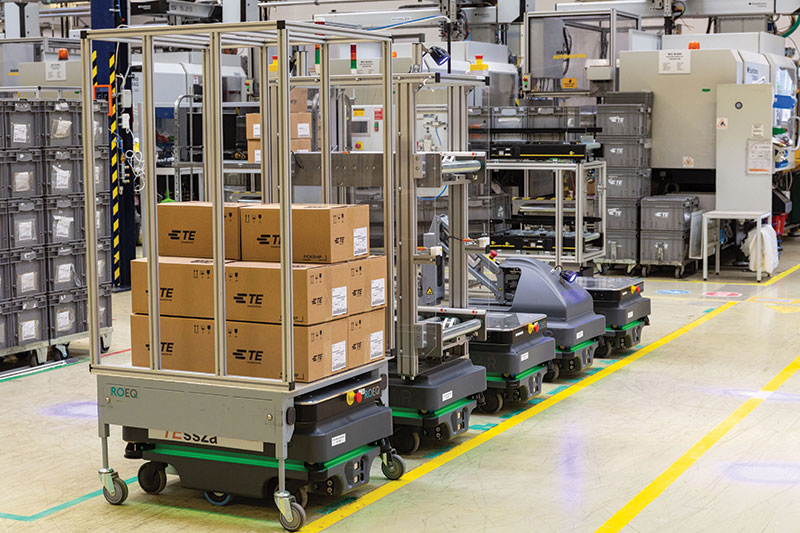Topping off AMR fleet performance
How TE Connectivity deployed special top modules, or mobile robotic equipment (MRE), to get performance boost from its autonomous mobile robot fleet.

More companies with materials handling operations are turning to autonomous mobile robots (AMRs) to automate processes like raw material container movements in a flexible manner, without the need for fixed infrastructure.
AMR vendors typically offer fleet software to manage routes, missions and monitor fleet productivity, making AMRs relatively easy to deploy and manage. However, to get the most from AMRs, mobile robotic equipment (MRE) has emerged. MREs such as top rollers and top modules help user organizations achieve higher effective payloads from AMRs, and also help AMRs interoperate with fixed automation like conveyors or other machinery.
TE Connectivity, a Tier2 supplier to global automotive supply chains, is among the companies benefitting from AMRs enhanced with MRE modules at a manufacturing plant it operates in Esztergom, Hungary, serving a variety of clients. To support its production activities, it needs to move raw materials into production work areas, and finished goods to other parts of the facility.
Back in 2019, TE’s Hungarian plant was experiencing problems in moving material due to the inefficiency of their existing systems, which had reached limits. Difficulties in securing enough manual material handlers made the situation more challenging. Digital transformation is part of TE’s goals, so the company made the decision to investigate mobile automation to address the issue.
TE’s staff began to assess their options, looking for a flexible system that was easy to operate and adapt. Safety was also a major consideration because of the narrow traffic routes in the plant, frequent changes in internal layout and tasks, and the continuous movement of raw materials, finished products and people on the factory floor.
To determine the best AMR for its needs, TE effectively turned its plant into an industrial test environment, experimenting with multiple solutions simultaneously. The search led the decision to deploy a fleet of AMRs (Mobile Industrial Robots or MiR) combined with MRE (ROEQ; short for Robotic Equipment) to automate some key processes.
The operation uses a combination of MiR200 AMRs combined with ROEQ TMC300 top modules, carts and docking stations. The top modules have the technology that communicates with the AMRs, while the carts carry materials, with the cart designed to distribute load weight, effectively boosting each AMR’s payload capacity while contributing to enhanced fleet productivity.
“Our fleet consists of six MiR200s, most of which carry raw materials and finished products between the warehouse and one of the value streams,” explains Gábor Miszler, continuous improvement analyst at TE. “What we have is a semi-automatic plant, as missions are launched by the employees who also have to move the carts connected to the robots both in the production area and in the warehouse. Therefore, simple docking and ease of use were placed high among our expectations regarding the modules.”
The six MiR200s perform two types of tasks. Five of the AMRs supply raw materials and finished products between the warehouse and the given value streams. The sixth AMR works in a fully automated setup with a special, custom-made module attached.
An automatic packaging station next to the injection molding machine counts the finished products and calls the robot automatically when the storage compartment is full. As part of the mission, the MiR200 picks up an empty bin, replaces it with a full one, and then transports and stores it in the warehouse. After an employee sets up and launches the robots directly using the MiR software, there is no need for human intervention.
The ROEQ TMC300 top module, with ROEQ cart and docking station, provided TE with a standardized solution that was easy to integrate since both the top module and the accompanying ROEQ Assist software are fully compatible with MiR’s system. With this integration, employees launching the missions do not have to learn how to operate two systems, and on top of that, regularly occurring tasks can be preprogrammed.
“This is precision technology, it was obvious from the first glance that it has been developed specifically for these devices,” says Miszler.
The TE Esztergom plant currently uses three ROEQ TMC300 top modules, 15 ROEQ 300E Easy-Pull-Out carts and 10 easy locking docking stations. The company is currently building a new production space optimized for AMR characteristics.
“Our achievements definitely encourage us to expand with automation,” says Miszler. “Our new production hall, currently under construction, has been designed with a layout already optimized for robots. We wish to expand the automated injection-molding technology and further automate materials handling and warehousing by deploying the robots in more and more applications.”

Article Topics
AMR News & Resources
6 River Systems handoff a sign for mobile robot vendors to demonstrate value, notes analysts 8 Reasons Why AMRs Beat Traditional Automation Locus Robotics heralds acquisition of Waypoint Robotics Driving warehouse productivity at ISN with AMRs Game-Changer: Warehouse management goes Cloud-firstLatest in Logistics
Prologis research paper examines impact of various technologies on logistics real estate efficiency Logistics services providers and shippers call out for seasonal help National weekly diesel average falls for first time in nine weeks, reports EIA 索引将序列impr功能处理量运输条件ovements UAW-Big Three strike is replete with supply chain implications Port Everglades: Expansion and Sustainability Efforts for the Future OOIDA blasts FMCSA move to mandate speed limiters on heavy trucks More LogisticsAbout the Author
About the Author
Subscribe to Logistics Management Magazine

Find out what the world's most innovative companies are doing to improve productivity in their plants and distribution centers.
Start your FREE subscription today.
September 2023
万博2.0app下载

Latest Resources














